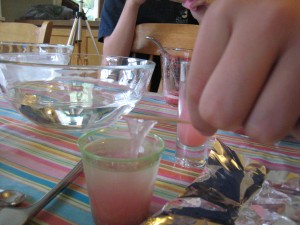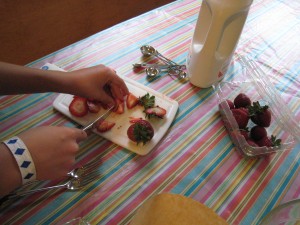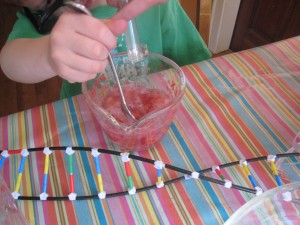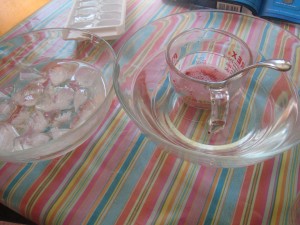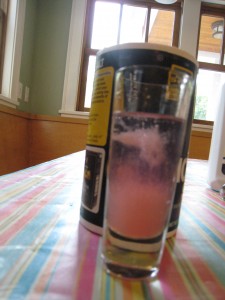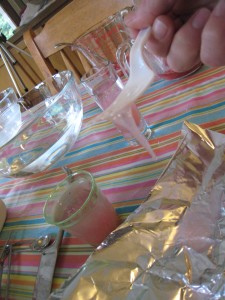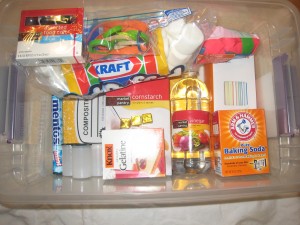Tag: kids’
Real Pirates and How to Make a Compass
- by KitchenPantryScientist
Last week at the Real Pirates exhibit at the Science Museum of Minnesota, I walked below deck on a mock pirate ship, hoisted a pirate flag (Jolly Roger), touched real pirate treasure and played dice with pirates. The bell of the Whydah, a 300-ton pirate ship greeted us, illuminated by lighting and suspended in a huge tank of water. I could almost imagine it spinning and tumbling to the bottom of the sea off the Massachusetts coast. 146 people aboard the ship drowned when The Wyhdah went down.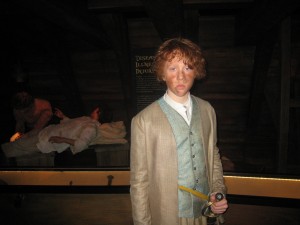
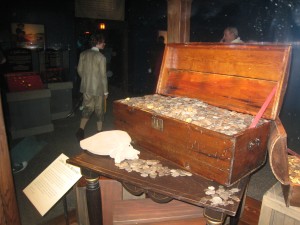
I was lucky enought to meet the treasure hunter-turned-historian Barry Cifford who discovered the wreck of the Whydah. He explained to us that pirate ships were true democracies, where crew mates were equal, no matter their background, age, race or religion. As a result ,many rushed to be pirates- whether they had escaped slavery, unjust society, or were just trying to make their fortune. The captain of the Whydah, Sam Bellamy, needed money to marry the woman he loved. There was even a 10-year old boy named John King aboard the Whydah when she went down…he left his mother to join the pirates. (My 11-year old claims he’d never do that.)
How did pirates navigate their way around the deep blue ocean well enough to ever utter the words “Land Ahoy?” In addition to maps and the stars, they used tools like the ones I saw from the Whydah: sounding weights to determine sea depth and ring dials to tell time. They also used compasses, simple tools for determining which direction North was, even in thick fog. A compass is an instrument containing a magnetized pointer that shows the direction of magnetic north, and you can easily make one with a needle, a magnet and a piece of cork or Styrofoam and a glass bowl (or pie plate) containing a few inches of water.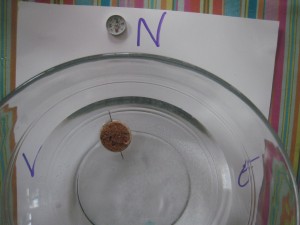 Cut a slice of cork, maybe 1/2 inch thick) with a bread knife (see photo.) Then, magnify the metal in your needle by stroking it from one end to another with a magnet about ten times. (Go the same direction each time.) Push your needle through the cork or Styrofoam and gently set it in the bowl of water. The needle, which you have turned into a magnet, will line up with Earth’s magnetic field, which runs from the South Pole to the North Pole. It should point North and South if you magnetized it correctly!
Cut a slice of cork, maybe 1/2 inch thick) with a bread knife (see photo.) Then, magnify the metal in your needle by stroking it from one end to another with a magnet about ten times. (Go the same direction each time.) Push your needle through the cork or Styrofoam and gently set it in the bowl of water. The needle, which you have turned into a magnet, will line up with Earth’s magnetic field, which runs from the South Pole to the North Pole. It should point North and South if you magnetized it correctly!
Kitchen Table DNA Extraction
- by KitchenPantryScientist
DNA, or deoxyribonucleic acid, contains all of the information needed to make every protein in a living thing and is sometimes called the “blueprint of life.”
This morning, on Kare11 Sunrise news, the kids and I showed viewers how easy it is to extract DNA from strawberries.
In higher organisms like plants and animals, DNA is stored in a compartment called a nucleus where the long, string-like DNA is tightly coiled. To separate DNA from the organism that contains it, you have to break the cells apart (lysis), filter out the big pieces of cell parts and collect the remaining liquid, or supernatent, and add chemicals like salt and alcohol to separate (precipitate) the DNA from the rest of the supernatent.
To extract DNA from strawberries at your own kitchen table, you’ll need: 3 strawberries, measuring spoons, 2 one or two-cup pyrex measuring cups, a cone-shaped coffee filter, a plastic zip-lock bag, small clear plastic or glass cups, laundry detergent (liquid or powdered), ice cubes, 2 big bowls, a timer, salt and ice-cold rubbing alcohol. *Always supervise children around cutting tools and alcohol.
Put the alcohol in the freezer at least an hour before you start the experiment so it gets cold enough to precipitate DNA. Make sure the bottle is well-labeled and you remove it when you are done since rubbing alcohol is poisonous if it is consumed by accident.
First, cut the strawberries into small pieces using a butter knife. Put the pieces in one of the pyrex measuring cups and mash them up well with a fork until you can’t see chunks any more.
Add a teaspoon of liquid or solid detergent to 1/2 cup of warm tap water, mix and pour this soapy mix over the strawberries. Fill one of the big bowls about half way with hot tap water (as hot as it comes from the faucet) and set the pyrex cup containing strawberries inside the bowl of warm water. Mix well with your fork. The detergent and warm temperature will start lysing (breaking up) the strawberry cells and proteins called enzymes will start chewing up cell parts, releasing the DNA from the nucleus. Wait 12 minutes, stirring the strawberry mixture once in a while.
Fill the other bowl about halfway with water and lots of ice cubes to make an “ice bath”. When the 12 minutes are up, set the cup containing the strawberry mixture into the ice bath for around 5 minutes, stirring once or twice. The cold temperature will slow the enzymes down so they don’t start chewing up the strawberry DNA.
While you wait, cut a plastic bag into a funnel the same size as your coffee filter and clip off the corner of the plastic bag so liquid can flow out (see photo). Put the coffee filter inside your plastic bag funnel and set the whole thing in your other pyrex measuring cup (or a wide glass.)
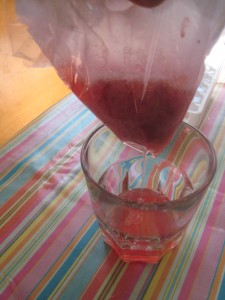
Put coffee filter inside plastic bag with tip cut off, pour strawberry mixture in and collect the supernatent.
When the 5 minutes are up, pour the strawberry solution into the filter/funnel and hold it while the strawberry gunk is filtered out and the supernatent containing the DNA flow through and into the cup below. If your filter gets clogged, use a spoon to carefully remove some of the strawberry gunk so more liquid can flow through. Don’t worry if you don’t collect every drop.
Now you get to precipitate the DNA! Pour some supernatent into your small, clear glass until it is about 1/3 full. Add about 1/4 teaspoon salt to the supernatant and mix it up well with a spoon or knife. Now, gently pour an equal volume (the same amount as your supernatent) of ice-cold alcohol into your supernatent. Do not mix it, but put your hand over the top of the glass and rock it gently. Set it down on the table and let it sit for a few minutes.
You should see a cloudy goo forming near the top of the liquid. It may look bubbly or slightly white. This is strawberry DNA.
You can use a toothpick or plastic fork to gently lift the DNA from the glass. It will look like clear slime.
Put it on a plate and touch it… how does it feel?
Congratulation scientist! You’ve just extracted DNA from a living organism!
*If you don’t see DNA, make sure you’ve added the salt. You can also set the entire glass in the freezer for half an hour if your alcohol wasn’t cold enough and the DNA should precipitate out!
Irresistible Physics
- by KitchenPantryScientist
When my 6-YO and her buddy asked whether they could make slingshots this morning, so they could shoot stuffed animals at a tower of blocks, I couldn’t say no. It’s physics after all. A few months ago, my kids had a great time making slingshots with their plush Angry Birds, as you can see in this video.
We got out a chair, some rubber bands, and a plastic ring like the ones they put on prescription bottles. Within minutes, they were laughing hysterically while stuffed bunnies flew through the air. Click here for detailed directions on how to make the slingshots and to learn more about slingshot physics.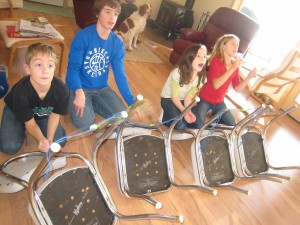
Marker Chromatography
- by KitchenPantryScientist
 You can take this project in many different directions, which is what science is all about! Chances are, you already have all the supplies you need for this project in your kitchen: coffee filters or paper towels, magic markers, and water.
You can take this project in many different directions, which is what science is all about! Chances are, you already have all the supplies you need for this project in your kitchen: coffee filters or paper towels, magic markers, and water.
Fill the bottom of a bowl or glass with a little water. Then, cut paper towels or coffee filters into long strips. Draw a large dot of color (black works best) about an inch from the bottom of the strip of paper. Place the bottom of the paper, below the dot, into the water. Once the water starts moving, the paper will stick to the side. You can hook it over the top of the glass, like we did.
 The water will be wicked up the paper and through the dot, dissolving and taking some of the dye up the strip with it. You’ll be able to see colors separate as the dyes travel up the strip. It’s fun to see what colors make up different black inks. My kids tried it with colors other than black too. They even made dots comprised of several different colors and watched them separate in the water. Another variation is to put ink on a large piece of paper, drip water on it from a dropper or straw and watch the color travel out in a circle!
The water will be wicked up the paper and through the dot, dissolving and taking some of the dye up the strip with it. You’ll be able to see colors separate as the dyes travel up the strip. It’s fun to see what colors make up different black inks. My kids tried it with colors other than black too. They even made dots comprised of several different colors and watched them separate in the water. Another variation is to put ink on a large piece of paper, drip water on it from a dropper or straw and watch the color travel out in a circle!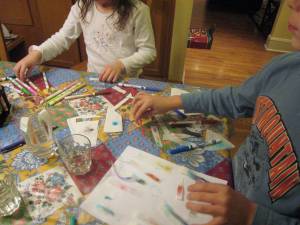
We taped some of the strips into our science notebooks. They’re very colorful. Older kids might enjoy trying a 10:1 mix of window cleaner and vinegar to separate the colors.
When you separate the colors from one another on the paper, you’re doing chromatography!
When paper is dipped in water, water molecules make it wet. The water molecules travel up the paper towel. When the water reaches the ink, it dissolves some of the dyes in the ink, and the dyes travel up the paper towel with the water. Some of the molecules that make up the dye are smaller and travel up the paper towel faster than the larger ones, so you can see some of the different colors that make up the ink separate from one another. The number of spots of color you see can tell you how many chemicals make up the color in your marker.
Most importantly, have fun!
Fizzy Balloon Outtake
- by KitchenPantryScientist
The kids and I got carried away and added a little too much baking soda and vinegar to our Fizzy Balloon experiment yesterday. Here’s what happened. 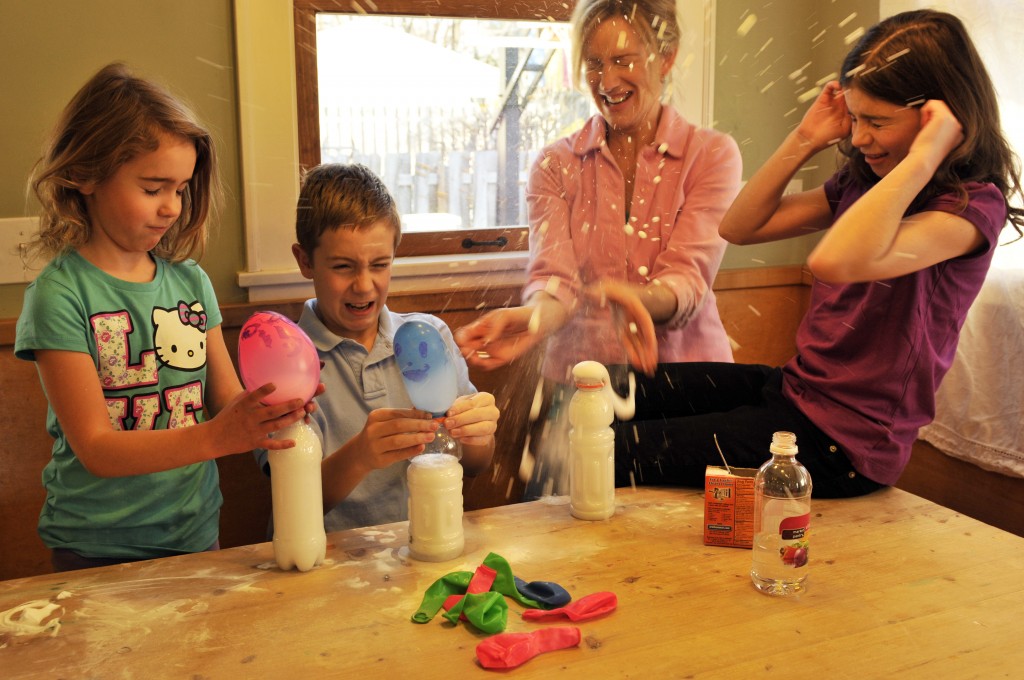 Pamela Diedrich of PD Photography was taking some pictures and captured the blast on film! Maybe next time we’ll measure a little more carefully.
Pamela Diedrich of PD Photography was taking some pictures and captured the blast on film! Maybe next time we’ll measure a little more carefully.
Homemade Science Lab
- by KitchenPantryScientist
Homemade science kits are fantastic, inexpensive holiday or birthday gifts. In addition, they’re great places to store loose science items you might already have around the house, like magnets or magnifying glasses. I’ll list how much some of the ingredients/stuff cost me at Target. In a single shopping trip, it’s easy to fill a plastic bin with enough supplies to do a number of science experiments (with a few last-minute additions from around the kitchen, like dish soap and milk.) The other morning, I talked about making your own science kit on Kare11 Sunrise. Pair your kit up with KidScience app for iPhones and iPods, and watch your kid turn your kitchen table into a science lab!
I’ll list some “ingredients” for science kits and link directly to the experiments in blue (just click on the experiment name.) You can print out directions from my website for older kids, or let younger kids watch the how-to videos on my website (see sidebar), so they can do them on their own. Better yet, just put down some newspaper and let them start mixing things together.
Safety goggles, petri dishes,magnets, plastic test tubes, eyedroppers, magnifying glasses, plastic beakers and graduated cylinders are great additions to any kit! Many of these are reasonably priced at Creative Kidstuff stores, if you live in the Twin Cities.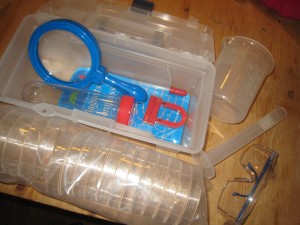
Here’s what we put in our kit:
composition book: really cheap at Target and makes a great science notebook to draw, record, and tape photos of experiments into.
baking soda: $.52 at Target can be used for a number of experiments like fizzy balloons and magic potion. Mix with vinegar to make carbon dioxide bubbles.
vinegar $1.12 at Target can be used for fizzy balloons , alien monster eggs and magic potion.
balloons for fizzy balloons are $1.75 at Target.
dry yeast for yeast experiment is around $1. 32 at Target
white coffee filters: can be used for magic marker chromatography or making red cabbage litmus paper.
cornstarch: $1.27 at Target can keeps kids busy playing with Cornstarch Goo, a non-newtonian fluid. Here’s the video.
marshmallows around $1.50 at Target with rubber bands and prescription bottle rings you have around the house can be used to make marshmallow catapults. My kids used theirs to make their own Angry Birds game.
Knox gelatine and beef bouillon cubes can be used to make petri plates for culturing microbes from around the house. You can also use the gelatine for cool osmosis experiments!
Food coloring $2.39 at Target can be used to learn about surface tension by making Tie Dye Milk. Here’s the video. You can also easily make colorful sugar-water gradients that illustrate liquid density!
Mentos mints will make a Mentos geyser when combined with a 2L bottle of Diet Coke.
drinking straws$1.09 at Target are great for NASA soda straw rockets and a carbon dioxide experiment.
film canisters with pop-in lids make amazing rockets. I wouldn’t include the Alka-Seltzer tablets you need to make them work in kits for younger children, since they’re technically medicine. These rockets would be amazing gifts for kids to make each other. They’re fun to make and decorate.
Decorating the bin with sharpies(or paint) and stickers is a great way to personalize it and fun for whoever is putting it together. Have fun!
Rainbow Sugar-Water Density Columns
- by KitchenPantryScientist
You can make colorful columns that demonstrate the concept of liquid density at your own kitchen table with just water, sugar and food coloring. An eyedropper, siphoning bulb, syringe (minus a needle,) or anything else that allows you to slowly drip liquid from one cup to another are useful for the layering step. If you have a tall, thin glass, like a cordial glass, or a test tube, it’s easy to see the layers in your gradient!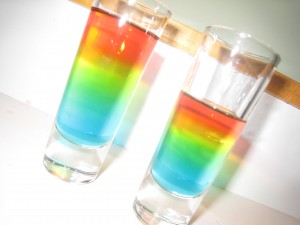
Start with two cups of hot tap water and measure half a cup into each of four cups. To the first cup, add 2 Tbs. sugar, to the second add 4 Tbs. sugar, to the third, 6 Tbs. sugar and to the fourth, 8 Tbs. sugar. Stir until the sugar dissolves. If the sugar won’t dissolve, an adult may microwave the cup for 30 seconds and stir again. Always use caution with hot liquids. If the sugar still won’t dissolve, try adding a Tbs. warm water.
Now, add 2 drops food coloring to each cup. We added red to the cup with 2Tbs, yellow to the one with 4Tbs, green to the to the one with 6Tbs, and blue to the cup with 8Tbs.
Density is mass (how many atoms are in an object) divided by volume (how much space an object takes up.) Sugar molecules are made up of lots of atoms stuck together. The more sugar you add to a half cup of water, the more atoms it will contain and the denser it will be. Less dense liquids float to the top of more dense liquids. Which of your sugar solutions is the most dense? The one with the most sugar in it (8 Tbs.)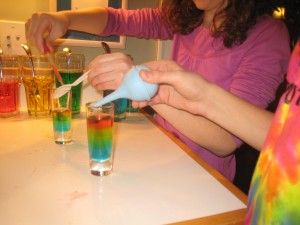
Put the most dense sugar solution(blue in this case) in the bottom of a tall, thin glass or test tube. Now, use your dropper to gently drip the next densest liquid (green) on top of the blue layer. It works best to drip the sugar solution against the side of the cup just above the surface of the liquid. You can also drip it onto the back of a spoon, like in the photo above. Add the yellow layer, and finally the red layer, which only contains 2Tbs sugar per half cup and is the least dense.
What happens if you mix the layers up? They won’t separate back out like oil and water would, because the sugar will disperse (spread) equally through the mixture.
Researchers sometimes use density gradients to isolate different parts of cells by breaking the cells up, putting the cell debris on top of a density gradient and spinning it in a centrifuge. Cellular fragments of different shapes and molecular weights move through the gradient at different rates.
Starch Test
- by KitchenPantryScientist
You probably know that lots of foods are full of starch, but did you know you can test foods in your own kitchen to see what has starch and what doesn’t? You can even see how starch is broken down by your own saliva by chewing a cracker for a long time and testing it for starch.
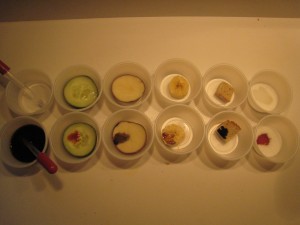 A simple disinfectant called iodine that kills bacteria and viruses can also be used to test for the presence of starch.
A simple disinfectant called iodine that kills bacteria and viruses can also be used to test for the presence of starch.
Starch is a carbohydrate, or a long chain of glucose (sugar) molecules stuck together by chemical bonds. All plants make starch, but some contain more than others. It is the most common carbohydrate in the human diet!
Iodine usually looks brown, but when long chains of starch interact with iodine, scientists think the iodine molecules get wrapped up in the chains, as if a snake is coiling around them. This changes the way the iodine reflects light, and it starts to look black or blue, instead of reddish-brown. Sugar that is not in long chains doesn’t do the same thing to iodine.
To test for starch in your own kitchen, you’ll need iodine, an eyedropper and the food you want to test. I’d suggest table sugar, potato slices, banana slices, cucumber slices, bread or anything else that is light colored. Dilute some iodine by adding about a teaspoon (5ml) of it to a teaspoon of water (5ml.) For each sample, have a control. For example, have two slices of bread: one to drop water on and another to drop iodine on. This experiment should be done with adult supervision since iodine should not be ingested!
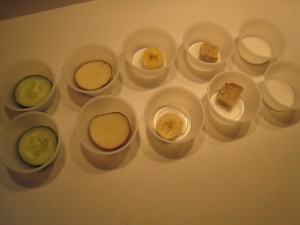
Add a drop of water to each control sample. Then, add a drop of iodine the other samples. Watch and wait for about 5 minutes. Can you tell which samples contain starch? The ones that contain the most starch will turn the iodine blue or black.
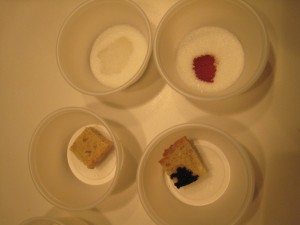
Now, take a cracker, chew it for a minute or so and spit it out into a dish. Mash another cracker up with water and put in another dish. Drip iodine on both of them and wait. What happens?
Gluten Ball
- by KitchenPantryScientist
Gluten is a hot topic these days, but most people aren’t really sure what it is.
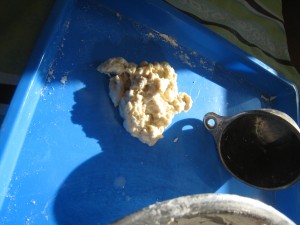
Gluten is a protein found in wheat, rye and barley. It makes bread chewy and helps hold the bubbles that yeast makes in dough so that it can rise. (Here’s a fun yeast experiment!) Although some people have a disorder called celiac disease which impedes them from digesting gluten properly, most people can eat it without any problem.
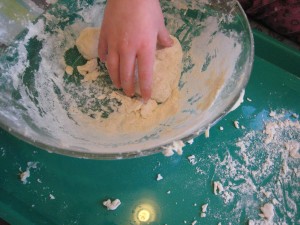
You can easily extract a ball of gluten from flour using nothing but your hands and cold water, to see for yourself what this stretchy grain protein looks like. Just add a cup of water to a cup of flour, mix it together and knead it for about 5 minutes. (Add more flour if it’s too sticky to handle.)
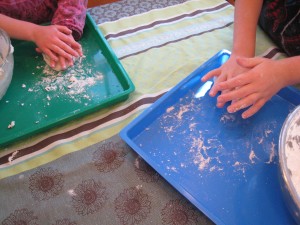
Now, put the dough under COLD water and start “washing” out the carbohydrates so that mostly the gluten remains. Your hands will freeze, so you may need to take a break. If you keep going until the water coming off the dough is mostly clear, you’ll be left with a gluten ball.
Some types of flour have more gluten than others, and sometimes extra gluten is added to pizza dough to make it chewier! Try this with several types of flour to see what has the most gluten (or no gluten.)
Frankenworms
- by KitchenPantryScientist
All you’ll need for this spooktacular experiment that we demonstrated on Kare11, are some gummy worms, scissors, baking soda, vinegar and water.
Cut some gummy worms into extra skinny worms by cutting them the long way with kitchen shears. If it’s too tricky, ask an adult to help with this part. Cut each worm lengthwise at least four times. The skinnier, the better! *Not all gummy worms are created equal. If your worms aren’t wriggling, dip them in baking soda before putting them in the vinegar!
Mix a few Tablespoons of baking soda into a cup or so of water, stir, and put your skinny gummy worms in the cup of baking soda solution. Let them soak for 15 or 20 minutes.
Fill a clear glass or jar up with vinegar. (Be careful not to splash any in your eyes.) When the 15 minutes are up, pull your worms out of the baking soda solution with a fork, and drop them into the glass of vinegar. What happens?
Your worms should start to float and move as the vinegar (acetic acid) reacts with the baking soda (sodium bicarbonate) to form carbon dioxide gas bubbles on the worms. They look like they’re alive and will wriggle until the chemical reaction stops!
